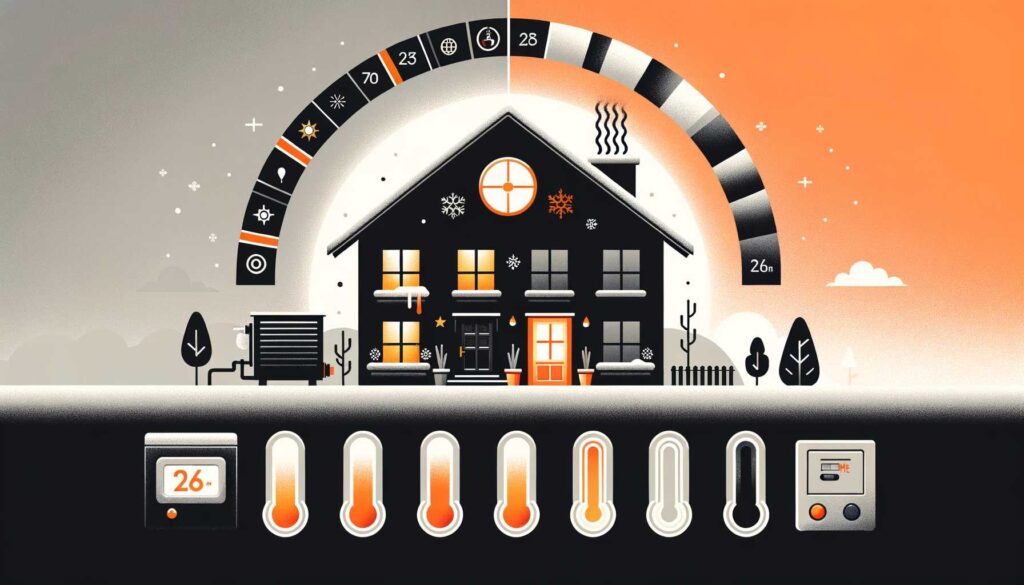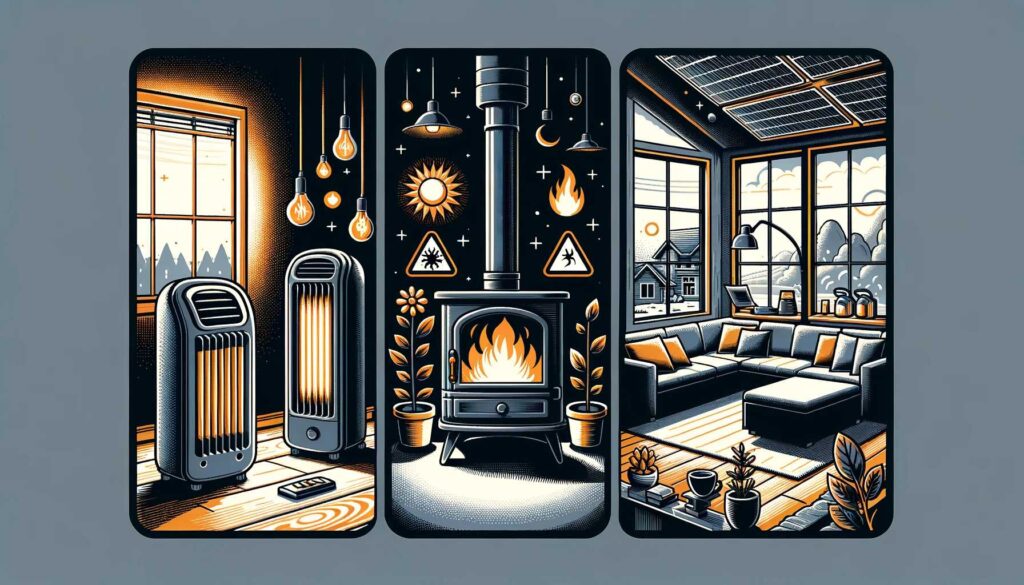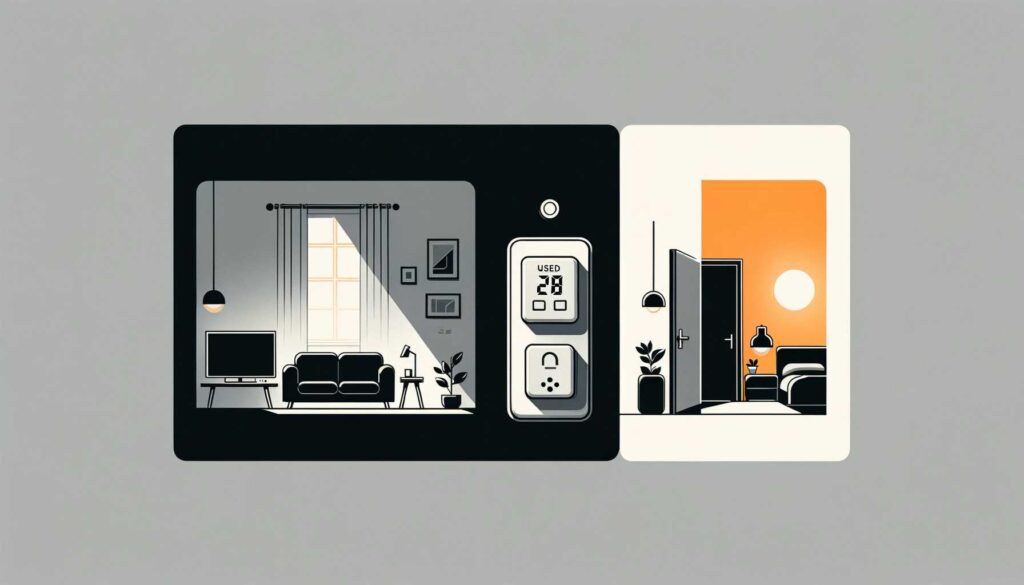Date: September 22, 2023
Introduction
At Champion Services, we understand how important it is to have a warm home during the winter months. We also understand that with colder temperatures come higher heating bills. That’s why we’ve created this comprehensive guide to help you lower your heating costs in the winter.
Throughout this guide, we will cover topics such as understanding your heating system, thermostat management, sealing and insulation improvements, utilizing alternative heat sources, mindful energy habits, maintenance and upgrades, smart home investments and being prepared for winter.
By implementing these strategies outlined in this guide, you can enjoy a cozy home throughout the winter without breaking the bank!
Understanding Your Heating System
When winter arrives, it’s important to make sure your home is warm and comfortable for you and your family. Unfortunately, this comfort often comes with a hefty price tag in the form of high heating bills. To reduce costs while still enjoying a cozy home, it’s essential to understand how your heating system works and what steps you can take to improve its efficiency.

Overview of Common Heating Systems and Their Efficiency
The type of heating system you have will determine how efficiently it runs and how much energy is used in the process. The most common types are furnaces, boilers, heat pumps, and electric baseboard heaters. Furnaces are the most popular choice due to their affordability and ease of installation; however, they tend to have lower efficiency ratings than other systems like heat pumps or boilers. Electric baseboard heaters are also popular but can be costly to operate since electricity rates are typically higher than natural gas rates.
The Significance of a Well-Maintained Heating System in Saving Energy
No matter what type of heating system you have, regular maintenance is key for keeping it running efficiently and saving energy over time. This includes changing filters regularly (at least once every three months), having annual professional tune-ups, cleaning vents and ducts as needed, checking for any air leaks or drafts that may be causing energy loss, and replacing any worn out parts or components that could be impacting performance. Taking these steps not only ensures that your heating system is functioning at its best but can also help you save money on energy bills in the long run.
|
Heating System
|
Efficiency Rating
|
Cost to Operate
|
|
Furnace
|
Low
|
Affordable
|
|
Boiler
|
High
|
Expensive (gas)
|
|
Heat Pump
|
High
|
Expensive (electricity)
|
|
Electric Baseboard Heater
|
Low-Medium
|
Expensive (electricity)
|
Thermostat Management
In order to save on heating costs in the winter, it is important to understand how to properly manage your thermostat. By making a few small changes, you can significantly lower your heating bills and make your home more comfortable.

Smart Thermostat Usage
One of the most effective ways to save energy when it comes to heating is using a smart thermostat. Smart thermostats allow you to set different temperatures for different times of day or night, allowing you to save energy when you’re away or asleep. Additionally, programmable thermostats can be set to turn down the temperature at certain times of day, such as overnight or when no one is home during the day. This will help reduce energy usage and lower your heating bills.
Benefits of Zonal Heating
Another way to save money on heating costs is by utilizing zonal heating. Zonal heating involves setting up multiple thermostats in different parts of your home so that each area can be heated separately depending on its needs. This allows you to heat only the areas that are being used, instead of wasting energy by heating an entire house unnecessarily. Additionally, zonal heating can help reduce drafts and keep rooms at a more consistent temperature throughout the day and night.
By understanding how to properly manage your thermostat and utilizing zonal heating techniques, you can significantly reduce your heating costs in the winter months while still keeping your home warm and comfortable. Utilizing these strategies along with other cost-saving measures such as sealing drafts and investing in energy-efficient upgrades will help ensure that you stay cozy all winter long without breaking the bank.
Main Idea: Utilize smart thermostats and zonal heating to reduce winter heating costs. Key findings: Smart thermostats can be programmed to lower temperature when no one is home, zonal heating allows for efficient heating of specific areas.
Sealing and Insulation Improvements
Sealing and insulation are two of the most effective ways to lower heating costs in the winter. Improperly sealed doors, windows and other openings can allow cold air to enter your home, forcing your heating system to work harder than necessary. Additionally, inadequate insulation can cause heat to escape from your home, resulting in higher energy bills. By taking a few simple steps, you can make sure that your home is properly sealed and insulated for maximum efficiency.
Identifying and Sealing Drafts
The first step in lowering your heating costs is to identify and seal any drafts that may be entering your home. Doors and windows are common sources of drafts, so it’s important to inspect them for gaps or cracks where cold air could be entering. If you find any openings, use weatherstripping or caulking to fill them in. You can also purchase draft stoppers for the bottom of doors if you need extra protection against drafts.
Enhancing Insulation
In addition to sealing off drafts, it’s important to make sure that your home is properly insulated. The attic and walls should be well-insulated with materials like fiberglass or cellulose insulation. This will help keep heat from escaping through these areas during the colder months of the year. It’s also important to insulate pipes and ductwork with insulation sleeves or wrap to prevent heat loss through these components as well.
By taking the time to properly seal and insulate your home, you can significantly reduce your heating costs in the winter months. In addition to making sure all doors and windows are sealed off properly, it’s important to check that your attic and walls are adequately insulated as well as any pipes or ductwork that may be present in your home. With a few simple steps, you can ensure that your home is as efficient as possible when it comes to conserving energy during the coldest times of the year!
Main Idea: Improving sealing and insulation can reduce heating costs by preventing cold air from entering the home and heat from escaping. Interesting Key Findings: Identify drafts, use weatherstripping or caulking, insulate attic and walls, insulate pipes and ductwork.
Utilizing Alternative Heat Sources
When it comes to keeping your home warm in the winter, there are a variety of alternative heat sources that can help you save on energy costs. From portable heaters to solar heat, these options can provide an additional layer of warmth and comfort during the coldest months of the year.

The use of portable heaters
Portable heaters are a great way to keep small areas of your home warm without having to turn up the thermostat or rely solely on your primary heating system. These devices typically run on either electricity or propane and are relatively inexpensive to purchase and operate. When using a portable heater, be sure to keep it away from furniture, curtains, and other flammable materials as they can pose a fire hazard if not used properly.
Embracing solar heat
If you live in an area with ample sunlight throughout the winter, then taking advantage of solar energy is an excellent way to reduce your heating costs. Solar energy can be used for both passive and active heating systems, depending on how much money you’re willing to invest upfront. Passive systems involve installing large windows that allow sunlight into your home during the day, while active systems require more complex installations such as solar thermal collectors or photovoltaic cells.
The advantages of a fireplace
While most modern homes don’t have a traditional wood-burning fireplace, there are still many ways to enjoy its warmth and ambiance without breaking the bank. Gas fireplaces are becoming increasingly popular due to their convenience and efficiency; they typically cost less than $1 per hour to operate compared to electric space heaters which can cost upwards of $4 per hour. If you’re looking for something more economical, consider investing in a pellet stove or wood stove – both are capable of providing significant amounts of heat while consuming much less fuel than traditional fireplaces.
Main idea: alternative heat sources such as portable heaters, solar heat and fireplaces can help save energy costs. Interesting key finding: Gas fireplaces cost less than $1 per hour to operate compared to electric space heaters which can cost upwards of $4 per hour.
Mindful Energy Habits
Saving energy and money doesn’t require a major overhaul of your heating system. There are simple, mindful habits that you can practice to reduce your winter heating costs.

Turning off Unused Lights and Electronics
One of the easiest ways to save energy is to remember to turn off lights and electronics when they’re not in use. This includes turning off televisions, computers, and other appliances when not in use. Additionally, it’s important to unplug all electronics when they’re not in use as some electronic devices still draw power even when turned off.
Benefits of Natural Light During the Day
Maximizing natural light during the day is another great way to reduce energy usage for lighting and heating needs. Open curtains or blinds during the day to let sunlight into rooms rather than using electric lighting or heaters. Doing so will help naturally warm your home and reduce your need for artificial lighting or heating sources during the day.
Closing Doors to Unused Rooms
For rooms that are not regularly used, consider closing the doors as much as possible to prevent heated air from escaping into those spaces unnecessarily. This will help keep more heat in your living areas while also reducing drafts throughout your home. Additionally, if you have an automated system with zonal heating, you can adjust temperatures for unused rooms accordingly so that they remain at a lower temperature while still providing enough warmth for occasional visits or activities in those spaces.
Maintenance and Upgrades
Regular maintenance of your heating system is one of the most important steps you can take to ensure that your energy bills don’t skyrocket during the winter months. Not only does regular maintenance help keep your system running efficiently, but it also helps to prevent costly repairs down the line.
Regular Furnace Maintenance
One of the simplest ways to maintain your furnace is by regularly changing the filters. Depending on the type of filter you have, you may need to change it as often as once a month or as little as every three months. This helps keep dust, dirt, and other debris from clogging up the system and affecting its performance.
In addition to changing the filters, it’s also recommended that you have a professional come in and do an annual tune-up on your furnace. This will help ensure that all parts are working properly and that there are no potential issues with any of the components. A professional can also identify any areas where your system may be losing energy so that you can address them before they become bigger problems.
Considering Energy-Efficient Upgrades
If your furnace is older than 10 years or if you notice that it’s not running as efficiently as it used to, investing in a newer model may be worth considering. Newer models tend to be much more efficient than their predecessors and can save you money in energy costs over time.
Another way to make sure your heating system is running at maximum efficiency is by upgrading any windows with single-paned glass to double-paned or even triple-paned glass. This will help trap heat inside your home better and reduce the amount of energy needed to keep it warm during cold winter days.
Finally, consider adding insulation around pipes and ductwork in order to further reduce heat loss from these areas. By making sure all areas are properly insulated, you can ensure that no heat escapes unnecessarily from your home and keeps energy costs low throughout the winter season.
By following these simple tips for maintaining and upgrading your heating system, you can rest assured knowing that you’re doing everything possible to keep your home warm without breaking the bank this winter season!
Table: heating system maintenance and Upgrades
|
Activity
|
Frequency
|
Benefits
|
|
Change Filters
|
Monthly/Quarterly
|
Prevents clogging & improves performance
|
|
Professional Tune-up
|
Annually
|
Ensures parts are working properly & identifies energy loss areas
|
|
Upgrade Furnace Model
|
As needed (10+ years)
|
More energy efficient & reduces energy costs over time
|
|
Upgrade Windows to Double/Triple-paned Glass
|
As needed (Single-paned)
|
Traps heat better & reduces energy use for warmth in winter months
|
|
Add Insulation to Pipes/Ductwork
|
As needed
|
Reduces heat loss & keeps energy costs low during winter season
|
Smart Home Investments
Investing in smart home technology can be a great way to help reduce heating costs during the winter months. Smart home devices such as thermostats, sensors, and other connected appliances can be used to monitor and adjust your heating system remotely. This allows you to set temperatures for different areas of your home, track energy usage, and even turn off the heat when it’s not needed. Additionally, some smart home systems offer automated scheduling so that you don’t have to manually adjust the temperature throughout the day. With these features, you can easily save money on your heating bills while still keeping your home comfortable during the cold winter months.
Being Prepared for Winter: A Summary
Recap of key takeaways for lowering heating bills
At Champion Services, we understand how important a warm home is in the winter and how costly it can be to heat your home. To help you save money on your energy bills, we’ve outlined ways to maximize the efficiency of your heating system, such as using smart thermostats and zonal heating, sealing and insulating your home, and utilizing alternative heat sources. We’ve also discussed mindful energy habits and maintenance and upgrade options that can help lower your heating costs. Finally, investing in smart home technology can also aid in reducing energy usage.
Encouragement to implement these strategies for a cozy, cost-effective winter
We hope this comprehensive guide has helped you identify ways to keep your home warm this winter while saving money on your energy bills. At Champion Services, we’re here to help with any HVAC repairs or maintenance services you may need this season. Contact us today for all of your plumbing and HVAC needs!

